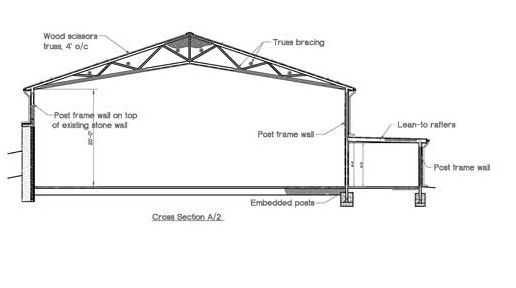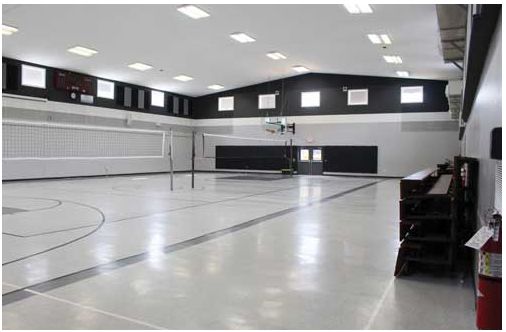This article’s content was published in Construction Magazine, October 28, 2016
Post-frame construction is ideal for non-code-exempt buildings of many shapes and sizes. One category of such structures that is often overlooked by post-frame builders is gymnasiums and multipurpose recreational buildings.
Gymnasiums and multipurpose recreational buildings are a perfect fit for post-frame construction for several reasons. Post-frame walls feature columns that run continuously from the foundation to the roof framing. These columns can be designed to accommodate the high ceilings that gymnasiums require. Long clear-span trusses allow for an open floor plan for basketball, volleyball and other sports, with scissors-style trusses used to create pitched ceilings that are higher in the center of the building. Large wall cavities allow plenty of room for insulation to meet or exceed energy code requirements. A variety of exterior siding and roofing materials can be used to create aesthetically pleasing architectural designs. The end result is post-frame gym and multipurpose recreational building designs that are cost efficient, highly functional, energy efficient and architecturally pleasing.
Building Code Classification and Requirements
Building codes classify buildings by type of occupancy and by type of construction. Occupancy type defines the end use of the building. Buildings (or parts of buildings) with the same end use are assumed to have similar life-safety characteristics, combustible contents and fire hazards. Construction type is used to define minimum fire ratings of building components (e.g., beams, columns) and assemblies (e.g., walls, floors, roofs). It is the combination of occupancy type (or use group) and construction type that largely dictates maximum building height and area.
Descriptions of the various occupancy and construction types can be found in Chapter 3 of the International Building Code. Two other IBC chapters of related importance are Chapters 5 and 9. Chapter 5 contains maximum allowable building heights and areas.
Chapter 9 contains requirements for fire protection systems based on the occupancy type (note: Chapter 9 requirements are independent of construction type). Chapter 9 provides the parameters of fire areas and occupant loads and is used to determine whether a project will require an automatic sprinkler system. Chapter 9 is used in conjunction with Chapter 7 to determine fire barrier and firewall requirements.
In accordance with the IBC, gymnasiums and multipurpose recreational buildings are typically assigned an Assembly (A) type of occupancy. If the building does not have spectator seating, it is classified as A-3. If it includes spectator seating, it is classified as A-4. All or part of these buildings may be classified as a Business (B) type of occupancy under the IBC if the building includes areas for training and skill development conducted outside of a school or academic program. This could include, for example, a building at a summer camp that is used for dance lessons or another business venture, rather than a typical gymnasium setting where games and practices are held.
Typical post-frame construction is classified as construction type VB, which means that the primary building elements are wood frame elements that don’t require fire protection. Assembly (A) buildings of type VB construction are limited to an allowable area of 6,000 square feet and to one story, per IBC Table 503. The maximum allowable area can be increased if all or a portion of the area surrounding the building meets access criteria (i.e., open perimeter requirements) for firefighting. The addition of an automatic sprinkler system will also provide an allowable area increase of 200 percent as well as an increase in the number of allowable stories—from one to two.
Post-frame buildings with primary structural building elements that have a 1-hour fire resistance rating can be classified as VA construction. Assembly (A) buildings of type VA construction are limited to an allowable area of 11,500 square feet and two stories, per IBC Table 503. Again, the maximum allowable area can be increased by providing firefighting access, automatic sprinklers or both. The inclusion of automatic sprinklers will also allow an increase in the maximum number of stories—from two to three.
The maximum fire area in assembly A-3 and A-4 buildings is limited to 12,000 square feet or less, per IBC Section 903.2.1, regardless of construction type. If the fire area exceeds 12,000 square feet, then an automatic sprinkler system is required. The use of 2-hour-rated fire barriers, per IBC Section 706, can create separate fire areas and eliminate the need for the sprinkler system.
Occupant load can be a major controlling factor in gymnasium and multipurpose recreational building design. The IBC bases occupant load on an allowable number of persons per square foot (i.e., how many individuals could fit in the space), not on the anticipated number of occupants in the building (see IBC Section 1004). Regardless of construction type, the maximum number of occupants in an A-3 or A-4 fire area is 299 before a sprinkler system is required. Gymnasiums and recreational buildings typically have large open floor plans, and applying the person-per-square-foot requirement results in a very high occupant load, and thus a load that typically requires a sprinkler system. If the calculated occupant load results in a number that is unrealistic, the issue can be discussed with the building code official, who has the authority to accept a lesser number or adjust the square-foot-per-person total in order to get a more reasonable result, per IBC Section 1004.1.1. When this is done, maximum-occupant-load signs must be posted at or near the main entrance and exit doors.
The structural design of post-frame gyms and multipurpose recreational buildings must conform to the structural load requirements compiled in IBC Chapter 16. Section 2306 of the IBC requires adherence to the National Design Specification for Wood Construction published by the American Wood Council (2015). The NDS establishes minimum design standards for all wood frame buildings. IBC Section 2306 also requires adherence to three documents of the American Society of Agricultural and Biological Engineers: EP484. Diaphragm Design of Metal-Clad, Wood-Frame Rectangular Buildings; EP486. Shallow-Post Foundation Design; and EP559. Design Requirements and Bending Properties for Mechanically Laminated Columns. Use of the NDS and ASABE documents for post-frame building design are covered in the Post-Frame Building Design Manual published by the National Frame Building Association (Bohnhoff, 2015).
Developing Special Building Packages
The authors strongly believe that no other building framing system is better suited for smaller gyms and multipurpose recreational buildings than post frame. Consequently, post-frame building construction companies may want to consider establishing standard plans for gyms and community centers as turnkey packages. In addition to the building shell itself, these standard packages could include special flooring, sports hardware options, bleachers, concession areas, lockers and other unique equipment.
We hope that this article will encourage conversation about these possibilities and encourage the use of post-frame construction in this market.
Timothy Royer is president of TimberTech Engineering Inc., Denver, Pennsylvania, and can be reached at trr@timbertecheng.com. Amanda Stauffer is building code specialist and computer-aided design drafter at TimberTech Engineering and can be reached at ant@timbertecheng.com.








